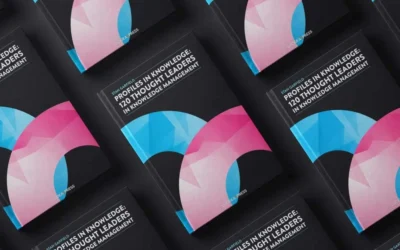KM Component 34 – Threaded Discussions and Enterprise Social Networks (ESNs)

Stan Garfield
Threaded discussions are tools for carrying on discussions among subscribers on a specific subject, including online and email posts and replies, searchable archives, and discussions grouped by threads to show the complete history of each topic.
Threaded discussions (also known as bulletin boards, listservs, newsgroups, message boards, discussion boards, online discussions, and forums), have now become the core functionality of enterprise social networks (ESNs).
An enterprise social network (previously called a microblog) is an internal, private social networking platform used for communications and collaboration within an organization. ESNs connect people across organizational boundaries, make it easy to share status updates, provide employee profiles for learning about and finding colleagues, and enable private, secure threaded discussions. The key use cases for ESNs are sharing information, asking questions, finding resources, answering questions, recognizing colleagues, informing about activities, and suggesting ideas.
In the past, bulletin board applications such as UBB.threads were frequently used, because they could be obtained inexpensively, installed, and integrated with the intranet and other collaboration tools. But now, Enterprise Social Networks (ESNs) are the more common solution.
Threaded discussions provide benefits to their subscribers and to the organization. They enable subscribers to learn from other members; share new ideas, lessons learned, proven practices, insights, and practical suggestions; reuse solutions through asking and answering questions, applying shared insights, and retrieving posted material; collaborate through conversations and interactions; and innovate through brainstorming, building on each other’s ideas, and keeping informed on emerging developments.
The organization benefits by having a reliable place where people with questions and problems can be directed to get answers and solutions, a searchable archive of the discussions, and a way for people to learn about their specialty and to develop in it. The broader the membership in a threaded discussion, the greater the benefit to the organization. This is due to having the widest possible range of perspectives, the greatest possible number of people to answer questions and solve problems, and greater leverage of all knowledge shared.
Providing a way for questions to be asked and answers to be supplied is a key function of threaded discussions. Subscribers post questions such as “has anyone done this before?”, “does anyone know how to do this?”, and “where can I find this?”, and other subscribers respond with answers, suggestions, and pointers to more information.
Another use of threaded discussions is sharing insights, techniques, and innovations with community members. Posting a tip on how a problem was solved, a customer was helped, or a breakthrough was achieved allows many others to reuse that knowledge in other contexts.
When used in conjunction with community events, repository contributions, and published articles, threaded discussions allow communities to reflect on the events, provide feedback on the contributions, and debate ideas in the articles. This extends the useful life of events, publicizes submitted content, and stimulates the lively exchange of ideas.
Email is the killer application for communications, and threaded discussions are the killer application for communities. There is a connection between these two applications: threaded discussion tools need to allow for reading and posting entirely by email. When selecting or implementing such a tool, be sure that full email functionality is provided so that subscribers will not have to visit an online site in order to participate in discussions. Allowing users to choose between email or online interaction is valuable; both options should be provided. See also Killer KM Apps Include Enterprise Social Networks (ESNs).
Threaded discussions have advantages over ordinary email with distribution lists. Here are some of the ways:
- Users can typically choose to collaborate using ESNs in one of three ways: online, entirely by email, or with mobile apps. This provides flexibility and accommodates personal preferences.
- Discussions are maintained in threads and can be more easily found and read.
- Threaded discussions can be searched from the specific platform or from enterprise search.
- When integrated with a KM recognition program, points can be automatically awarded for posts and replies to encourage participation.
- The user experience is greatly improved by actively managing ESN groups to weed out dead ones, help community managers successfully build new ones, and avoid redundancy and topics which are too narrow or restrictive.
If your organization has people who don’t all speak the same language, you may wish to implement threaded discussions in varying local languages. If English is the organization’s main language, then for topics of worldwide interest, ensure that at least one subscriber who speaks English well is assigned to subscribe to the corresponding English language discussion. Then, if something important is discussed in the English version, the assigned translator can relay this to the local language version, and vice versa.
There are guidelines for threaded discussions to keep them operating effectively. Here are three typical problems in how people post to threaded discussions along with recommended solutions.
- Many people may be reluctant to post to a discussion. For details, see Reluctance to Ask in KM Participation – How to Overcome Reluctance Part 2.
- Some subscribers reply to posts or digests without deleting the original text. When replying to a post, include just the text you wish to quote in response, and delete the rest. This will prevent the discussion from being cluttered with redundant text, and will make it easy to distinguish between new and old posts.
- Other subscribers send messages intended for one person to the whole list or send messages to a few people which should be sent to the whole list. If you are replying to one member with a message intended just for them, do it in a separate email directed to that person only. Conversely, if you have a question or comment of general applicability, don’t send it to a small subset of the members. Post it to the threaded discussion so that all can learn from it and respond to it.
Example: Yammer

Platforms
Public Discussion Groups
Private Enterprise Social Networks

Stan Garfield
Please enjoy Stan’s additional blog posts offering advice and insights drawn from many years as a KM practitioner. You may also want to download a copy of his book, Proven Practices for Implementing a Knowledge Management Program, from Lucidea Press. And learn about Lucidea’s Inmagic Presto and SydneyEnterprise with KM capabilities to support successful knowledge curation and sharing.
Similar Posts
Only You Can Prevent Knowledge Loss: How to Practice “Knowledge Archaeology”
An overview of ways in which knowledge is lost, with examples of how to perform knowledge archaeology to recover and restore it.
Ready to Read: Profiles in Knowledge: 120 Thought Leaders in Knowledge Management
We are pleased to announce that Stan Garfield’s new book, Profiles in Knowledge: 120 Thought Leaders in Knowledge Management, is now available from Lucidea Press.
Lucidea’s Lens: Knowledge Management Thought Leaders Part 92 – Jay Liebowitz
Jay Liebowitz is a professor, consultant, author, and editor. His research interests include knowledge management, data analytics, intelligent systems, intuition-based decision making, IT management, expert systems, and artificial intelligence.
Lucidea’s Lens: Knowledge Management Thought Leaders Part 91 – Frank Leistner
The late Frank Leistner was the former Chief Knowledge Officer for SAS Global Professional Services, where he founded the knowledge management program and led a wide range of knowledge management initiatives up until 2012.




Leave a Comment
Comments are reviewed and must adhere to our comments policy.
0 Comments